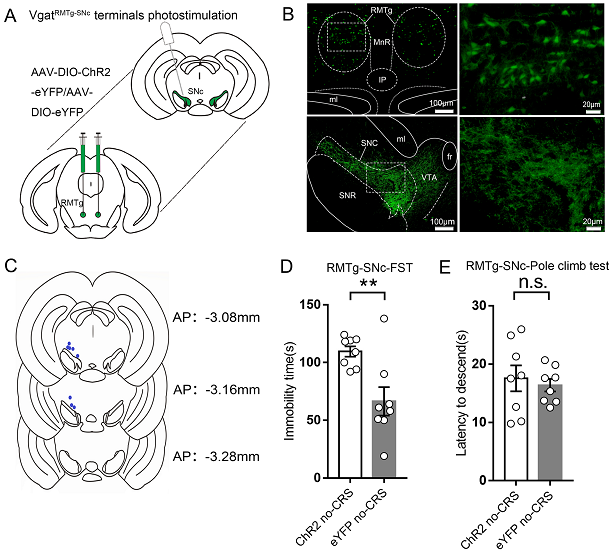AAV-hChR2 and AAV-eNpHR3.0 were used for optogenetic manipulation. (From
BrainVTA)
The viruses used in this article from BrainVTA are in the table below
|
Optogenetic |
PT-0001 AAV2/9-EF1a-DIO-hChR2(H134R)-EYFP-WPRE-pa
PT-0007 AAV2/9-EF1a-DIO-eNpHR3.0-mCherry-WPRE-pa |
|
Control |
PT-0012 AAV2/9-EF1a-DIO-EYFP-WPRE-pa |
Yanfei Sun, Jing Cao, Chunpeng Xu, Xiaofeng Liu, Zicheng Wang, Hua Zhao
Pub Date: 2020-08-10,
DOI: 10.1016/j.expneurol.2020.113433,
Email: sales@brainvta.com
GABAergic neurons in the rostromedial tegmental nucleus (RMTg) receive major input from the lateral habenula (LHb), which conveys negative reward and motivation related information, and project intensively to midbrain dopamine neurons, including those in the ventral tegmental area (VTA) and substantia nigra pars compacta (SNc). The RMTg-VTA circuit has been shown to be linked to the affective behavior, but the role of the RMTg-SNc circuit in aversion and depression has not been well understood. This study demonstrated that exciting or inhibiting VgatRMTg-SNc neurons was sufficient to increase or decrease immobility time in the forced swim test (FST), respectively. Furthermore, exciting the VgatRMTg-SNc pathway caused aversive behavior. Ninety percent of the SNc putative dopamine neurons were inhibited in extracellular recordings. Furthermore, inhibiting the VgatRMTg-SNc pathway reversed behavioral despair in chronic restraint stress (CRS) depression model mice. Manipulations of the pathway did not affect the hedonic value of the reward in the sucrose-preference test (SPT) or general motor function. In conclusion, these results indicate that the VgatRMTg-SNc pathway regulates aversive and despair behavior, which suggests that the RMTg may mediate the role of LHb in negative behaviors through regulating the activity of SNc neurons.
 Figure 1. Activation of the Vgat RMTg-SNc pathway increased immobility time in the FST and has no effect on SPT.
Figure 1. Activation of the Vgat RMTg-SNc pathway increased immobility time in the FST and has no effect on SPT.
The study is aimed to explore the role of the RMTg-SNc circuit in aversion and depression. In this study, the authors used optogenetic, combined with electrophysiological and behavioral methods to test our hypothesis that RMTg-SNc pathways contribute to depressive behavior. The results indicate that the VgatRMTg-SNc pathway regulates aversive and despair behavior, which suggests that the RMTg may mediate the role of LHb in negative behaviors through regulating the activity of SNc neurons.
BrainVTA offers viral vector construction & virus packaging services for AAV, LV, RABV, PRV, HSV and VSV that help researchers explore questions about genes, neurons, circuitry structure, function of brain network, mechanism and treatment of diseases.
If you have any needs, just email us at
sales@brainvta.com.
